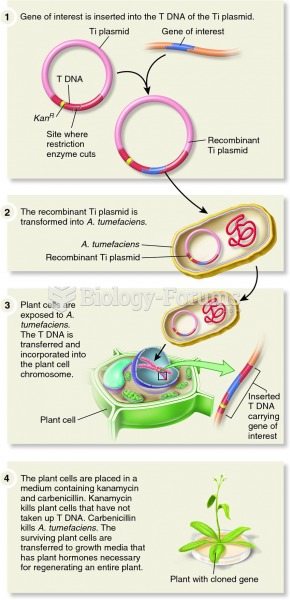Answer to Question 1
Answer: 1, 2, 3, 5
Explanation: 1. The reason for the visit, age of the client, neighborhood, and client's support systems are all considerations in planning a home visit. The reason for the visit sets the tone for the home visit, and the age of the client allows the nurse to perform any health teaching and intervention at an appropriate level. Knowing the surrounding neighborhood for safety allows the nurse to plan an appropriate time for the home visit. In the planning phase, the nurse needs to have some preliminary treatment goals in mind for the client based on the information received prior to the visit but remain aware that these may be modified or amended when the assessment is completed. The ability of the client to pay for services is important but is not a necessary step for planning the visit.
2. The reason for the visit, age of the client, neighborhood, and client's support systems are all considerations in planning a home visit. The reason for the visit sets the tone for the home visit, and the age of the client allows the nurse to perform any health teaching and intervention at an appropriate level. Knowing the surrounding neighborhood for safety allows the nurse to plan an appropriate time for the home visit. In the planning phase, the nurse needs to have some preliminary treatment goals in mind for the client based on the information received prior to the visit but remain aware that these may be modified or amended when the assessment is completed. The ability of the client to pay for services is important but is not a necessary step for planning the visit.
3. The reason for the visit, age of the client, neighborhood, and client's support systems are all considerations in planning a home visit. The reason for the visit sets the tone for the home visit, and the age of the client allows the nurse to perform any health teaching and intervention at an appropriate level. Knowing the surrounding neighborhood for safety allows the nurse to plan an appropriate time for the home visit. In the planning phase, the nurse needs to have some preliminary treatment goals in mind for the client based on the information received prior to the visit but remain aware that these may be modified or amended when the assessment is completed. The ability of the client to pay for services is important but is not a necessary step for planning the visit.
5. The reason for the visit, age of the client, neighborhood, and client's support systems are all considerations in planning a home visit. The reason for the visit sets the tone for the home visit, and the age of the client allows the nurse to perform any health teaching and intervention at an appropriate level. Knowing the surrounding neighborhood for safety allows the nurse to plan an appropriate time for the home visit. In the planning phase, the nurse needs to have some preliminary treatment goals in mind for the client based on the information received prior to the visit but remain aware that these may be modified or amended when the assessment is completed. The ability of the client to pay for services is important but is not a necessary step for planning the visit.
Answer to Question 2
Answer: 3
Explanation: 3. Visiting the homes of this population to address health concerns is an aspect of health promotion and illness prevention. The client is in a familiar environment and is more comfortable, which makes teaching easier for the nurse. The population is not indicated as sick. Case finding and referral would apply if the nurse was seeking something specific among this population. Health protection is part of health promotion, but is more of a broad-scale activity done to maintain health.







